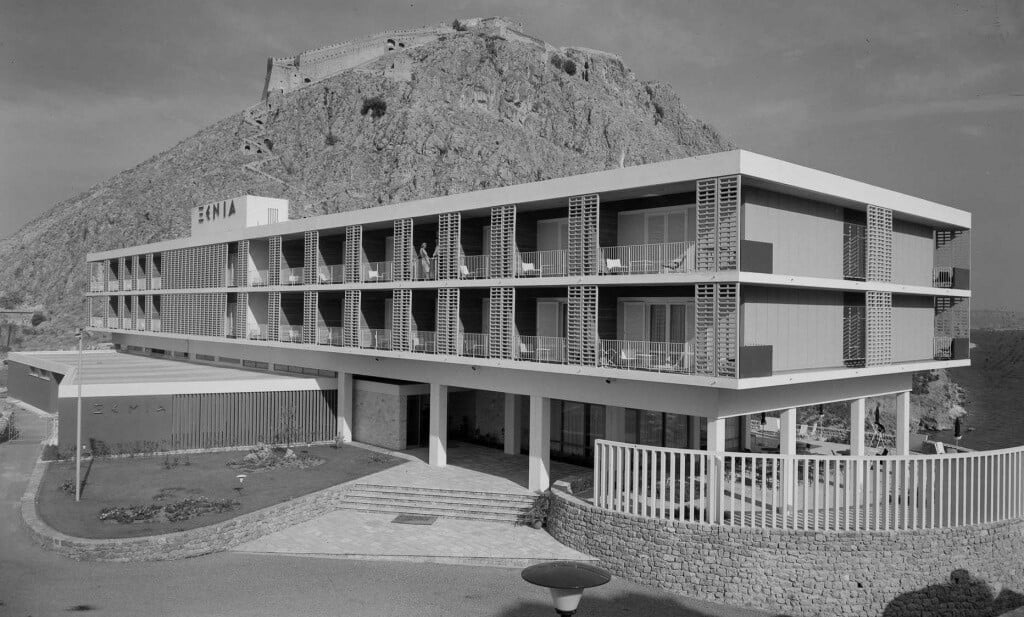

The “Xenia” hotels, initiated as part of Greece’s post-war tourism strategy, aimed to showcase the country’s natural beauty and attract international visitors.
Today they stand in many areas of the country like ghosts of a past that began with the ambitious intention to create a domestic tourism industry.
Implemented from 1953 to 1967 under the Greek National Tourism Organization (GNTO), the program included hotels, motels, tourist kiosks, and organized beaches strategically located across Greece. This ambitious project was pivotal in promoting Greece globally, leveraging tourism as a cornerstone of economic recovery following World War II.
Designed by prominent architects like Aris Konstantinidis, the Xenia hotels represented a unique blend of modernism adapted to Greece’s landscape. These hotels were envisioned not only as accommodations but also as integral parts of their natural surroundings, emphasizing communal spaces to integrate with local communities.
His quote, “I believe in dreams, not fantasy,” marked the life and work of famed Greek architect Konstantinidis (1913-1993).
Long heralded as the father of Greek architectural modernism, Konstantinidis built many iconic buildings around Greece during his long career, and helped expand Greece’s tourism industry with his many hotels.

They marked a departure from traditional hospitality, catering not just to elite tourists but also to the burgeoning middle class, fostering accessibility and broadening tourism’s social impact.
The Xenia program was intertwined with the history of the GNTO, which was re-established in 1951 to spearhead tourism reconstruction. It played a crucial role in defining the aesthetic and functional standards for Greek tourism infrastructure, setting a benchmark that influenced subsequent private sector developments.

Despite its eventual decline, the Xenia program left a lasting imprint on Greece’s tourism identity, blending modern architectural principles with local cultural and environmental sensitivities.
Aris Konstantinidis, in particular, revolutionized the Xenia design ethos, introducing bold architectural styles that harmonized with Greece’s natural settings. His approach emphasized integration into landscapes and utilized materials that reflected local traditions while embracing modern construction techniques. This distinctive aesthetic not only defined the Xenia hotels but also influenced subsequent private hotel developments in Greece.

However, by the late 1980s, shifts in tourism demands and government management challenges led to the decline of the Xenia hotels. The state’s role as a hotelier became unsustainable, and many Xenia sites fell into disuse and neglect. The last state-operated Xenia closed in 1997, leaving behind a legacy of architectural experimentation and a symbol of an era when state-led initiatives shaped Greece’s tourism landscape.
The decline of the Xenia hotels coincided with the rise of international hotel chains like Hilton, which introduced a different architectural paradigm emphasizing luxury and scale. This marked a significant departure from Xenia’s minimalist approach, highlighting contrasting visions for Greece’s tourism future.
Today, efforts are underway to preserve and repurpose some Xenia sites, recognizing their cultural and historical significance. The revival of boutique hotels in the 1980s and beyond echoes Xenia’s original ethos of small-scale, community-integrated hospitality. These initiatives seek to blend modern tourism demands with respect for architectural heritage, proposing adaptive reuses that could transform Xenia sites into cultural hubs and community spaces once more.
While the Xenia hotels no longer dominate Greece’s tourism landscape as they once did, their legacy as pioneers of modern Greek hospitality endures.
They represent a pivotal chapter in Greece’s post-war reconstruction, shaping architectural and cultural narratives that continue to influence contemporary tourism development strategies.
As Greece navigates its tourism future, preserving the Xenia legacy offers insights into sustainable tourism practices and the potential for adaptive reuse to revitalize cultural landmarks for future generations.
